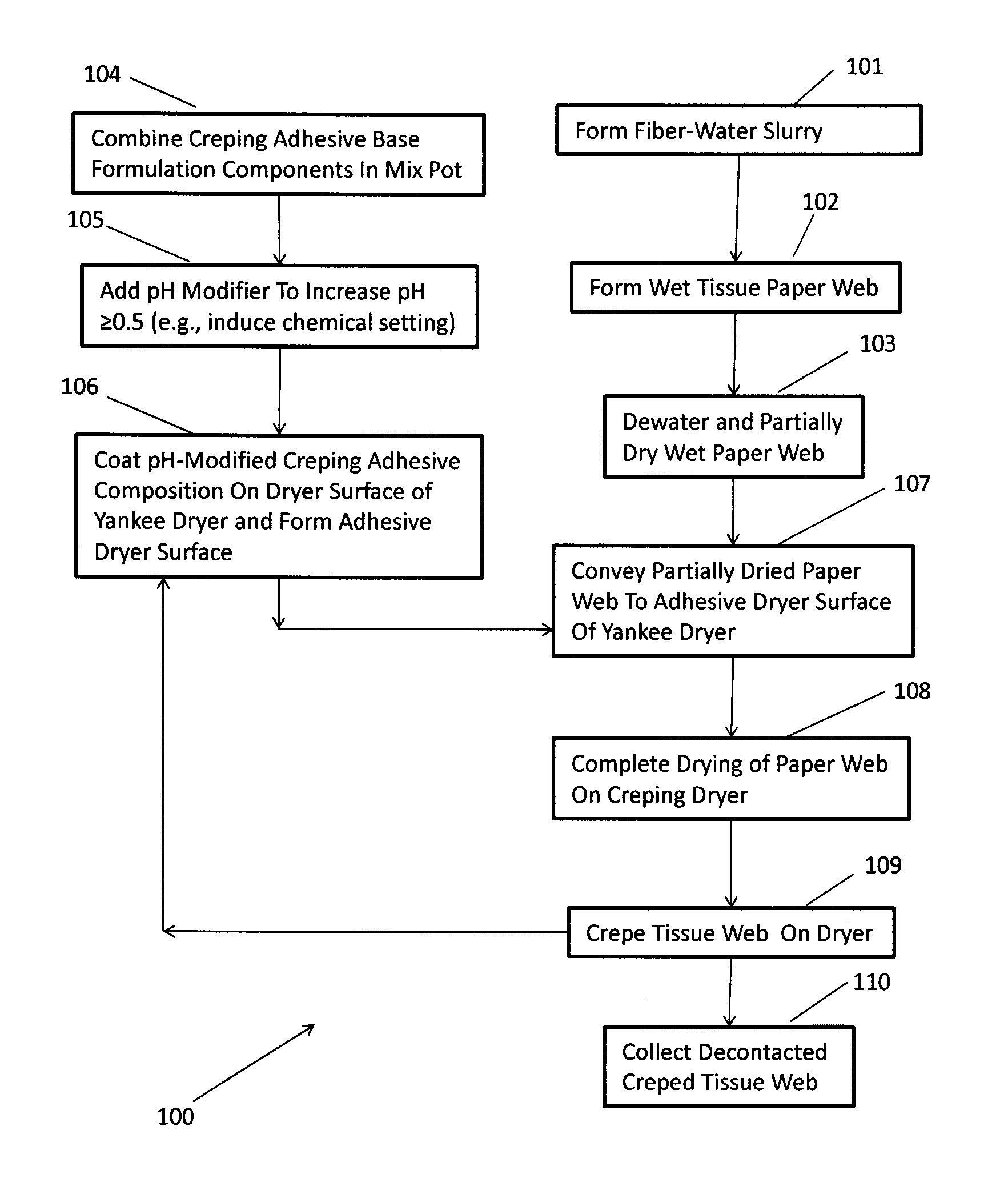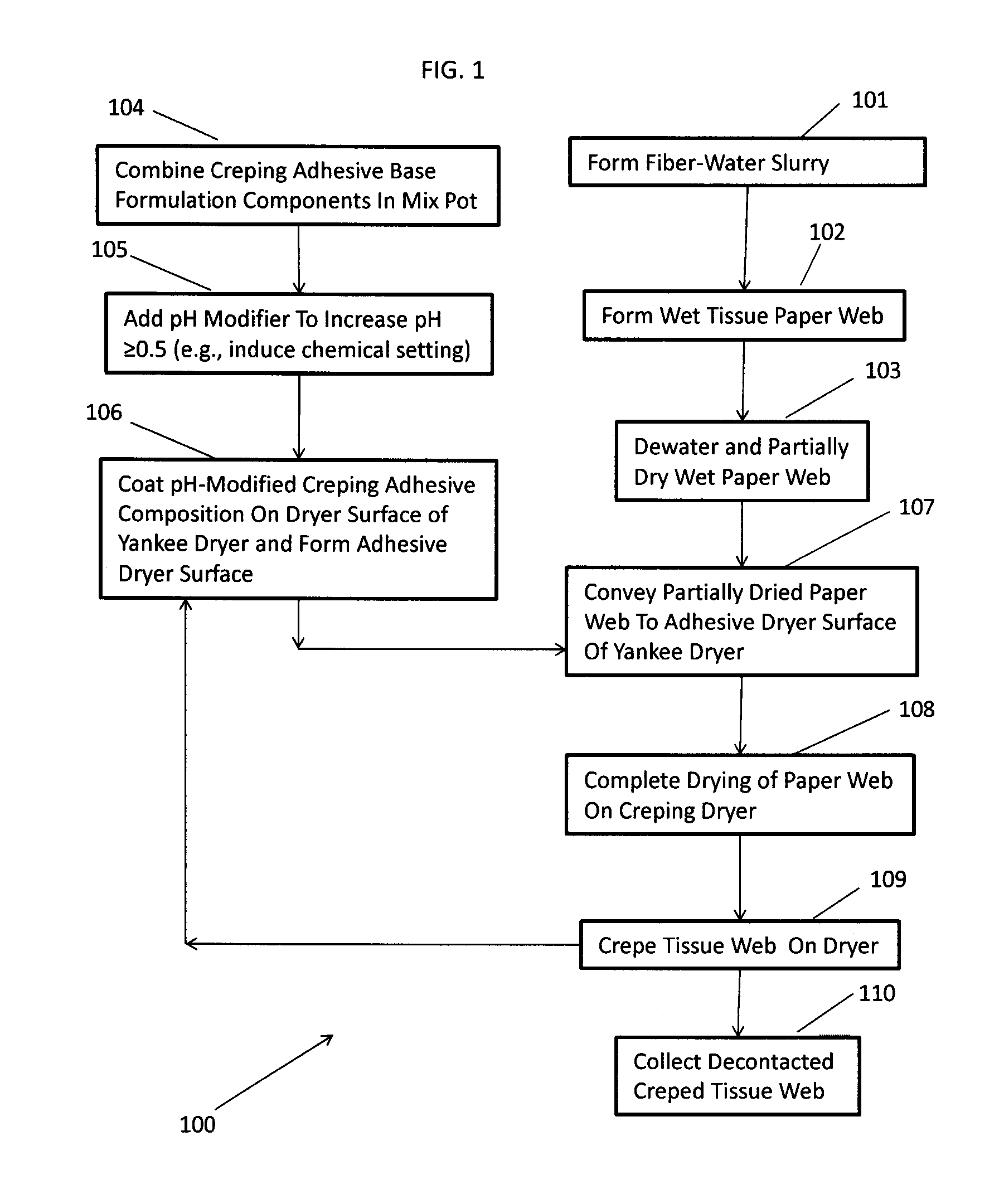Creping methods using pH-modified creping adhesive compositions
a technology of creping adhesive and composition, which is applied in the field of crepe paper manufacturing, can solve the problems of web breakage, chattering or bouncing of the blade, and many conventional creping adhesives are not rewettable, and achieve the effect of enhancing creping performan
- Summary
- Abstract
- Description
- Claims
- Application Information
AI Technical Summary
Benefits of technology
Problems solved by technology
Method used
Image
Examples
example 1
[0078]In this Example, an adhesive base formulation was prepared which contained a polymer containing composition of CREPETROL® 5318, a commercial PAE creping adhesive (Hercules Incorporated), and a release agent, BUSPERSE® 2097 (Buckman Laboratories International Inc.), in an aqueous dispersion. An eight foot diameter Yankee dryer was used for creping the towel fiber sheet, which dryer had a suction press roll. Pressure on nozzle was approximately 108-110 psi, and running speed was adjusted from about 2600 to about 2900 feet / minute (FPM). This machine was a semiwet crepe design with a flat former. The fiber sheet had a moisture content of approximately 60-70 wt. % as transferred to the Yankee dryer, and moisture content of approximately 15-20 wt. % when the creped product was removed from the dryer. The Yankee dryer and reel speeds, in feet per minute (FPM) units, pump setting, and the dryer hood temperature in degrees Fahrenheit (° F.), used in this study are indicated in the tabl...
example 2
[0079]A separate study was run on a 10 foot diameter Yankee dryer used for creping napkin grade paper sheets, which has a 22.5 millisecond dwell. 10 wt. % NaOH solution was fed into a mix pot. About 10 cc per minute of the caustic was added. A similar formulation of adhesive and release agent as used in Example 1 was also used in this example. The fiber sheet had a moisture content of approximately 60-70 wt. % as transferred to the Yankee dryer, and moisture content of approximately 8-10 wt. % when the creped product was removed from the dryer. The Yankee dryer and reel speeds, in feet per minute (FPM) units, pump setting, and a Yankee temperature of 56° F., used in this study are indicated in the table in FIG. 4. The initial pH was 5.9 and the caustic was added to increase the pH to about 7.6. The amount of CREPETROL® 5318 adhesive coating rate was able to be reduced from 3.1 mg / m2 to 2.4 mg / m2 (about 20% reduction) without streaking or chatter while leaving the release agent (BUSP...
example 3
[0080]A separate study was run on a 18-foot diameter Yankee dryer which handled 12# towel grade sheets at 12 wt. % to 14 wt. % moisture. 10 wt. % NaOH solution was fed directly into the fresh water as it made up level in a mix pot. About 15-35 cc per minute of the caustic was added. In this Example, an adhesive base formulation was prepared which contained a polymer containing composition of BUBOND® 2624, a commercial modified polyamine-type creping adhesive (Buckman Laboratories International Inc.), and a release agent, BUSPERSE® 2097, in an aqueous dispersion. The fiber sheet had a moisture content of approximately 65-70 wt. % as transferred to the Yankee dryer, and moisture content of approximately 5-10 wt. % when the creped product was removed from the dryer. The Yankee dryer speed was 4500-5500 FPM and the reel speed was 4000-4500 FPM. The Yankee temperature was 180-210° F. and the pressure was 90-110 psi. The initial pH was 5-6.5 and the caustic was added to increase the pH to...
PUM
| Property | Measurement | Unit |
|---|---|---|
| diameter | aaaaa | aaaaa |
| temperature | aaaaa | aaaaa |
| pH | aaaaa | aaaaa |
Abstract
Description
Claims
Application Information
 Login to View More
Login to View More - R&D
- Intellectual Property
- Life Sciences
- Materials
- Tech Scout
- Unparalleled Data Quality
- Higher Quality Content
- 60% Fewer Hallucinations
Browse by: Latest US Patents, China's latest patents, Technical Efficacy Thesaurus, Application Domain, Technology Topic, Popular Technical Reports.
© 2025 PatSnap. All rights reserved.Legal|Privacy policy|Modern Slavery Act Transparency Statement|Sitemap|About US| Contact US: help@patsnap.com



